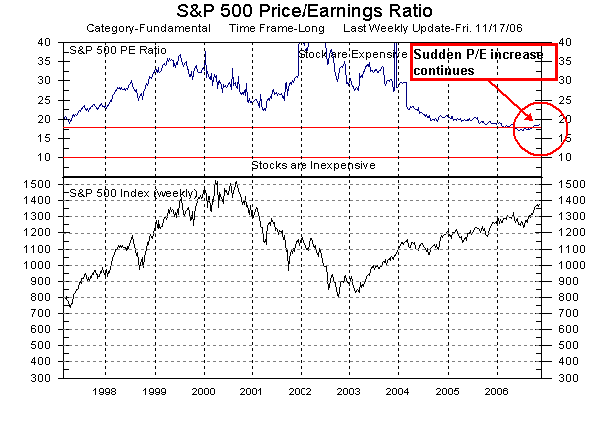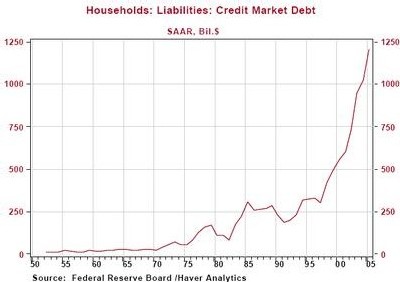
Dynamics

|
Generational Dynamics |
| Forecasting America's Destiny ... and the World's | |
| HOME WEB LOG COUNTRY WIKI COMMENT FORUM DOWNLOADS ABOUT | |
The stock market has reached a fresh record high almost every day in the last couple of weeks. The Dow Jones Industrial Average (DJIA) closed at 12343 on Friday, overpriced by a factor of 242%, according to long-term exponential growth projections.
This level of overpricing (240%+) was reached on 16-Aug-1929, two weeks before the stock market crash, and then again in July, 1997, three years before the Nasdaq crash of 2000.
What I find to be really startling is that price/earnings ratios are starting to rise again, after falling steadily for over 2½ years.
 |
This increase, which began about a month ago, means that investors are suddenly becoming increasingly risk-seeking, and so increasingly giddy in their investment decisions. Is this a sign of investor overconfidence, or a sign of investor desperation? Time will tell which.
The stock market isn't the only place where bubblicious giddiness is evident.
The global derivatives market grew by 25% in the first half of this year, a phenomenal rate of growth. As we described a couple of weeks ago, $300 trillion in derivatives is based on just $65 trillion of underlying stocks and bonds.
Now we learn that the derivatives market rose to $370 trillion by the end of June, 2006. The stock market bubble is gradually becoming larger and larger, but the derivatives bubble is blowing up at a phenomenally rapid rate. It's no exaggeration to say that the global financial market today is almost completely controlled by the derivatives market, not by stocks and bonds.
The fastest growing and largest segment of the derivatives market is credit derivatives, capturing $262 trillion of the total $370 trillion.
Credit derivatives permit investors to spread risk around, presumably making the global financial markets more stable. In simplest terms, credit derivatives allow an investor to bet whether interest rates are going to go up or down.
That's like betting Red or Green on a roulette wheel. How could that possibly make the global financial markets more stable? At least when everyone is investing in stocks and bonds, then it's possible (and likely, over the long term) that EVERYONE will make money. But when you bet on a roulette wheel, you're simply gambling on chance, and one man's gain is another man's loss.
And since these credit derivative instruments are sold and resold, often to the same people, at increasingly high prices, you actually have a worldwide pyramid scheme based on a worldwide gambling enterprise.
The argument that the derivatives market makes the financial system more stable is very widely believed among investors. Alan Greenspan has made that claim several times.
The head of an industry group says, "Derivatives are a power for the good of the financial system as a whole. Not only do they help individual businesses better adapt their risk profiles but they benefit the financial system by disaggregating risk more broadly."
That derivatives make the global financial system more stable is far from clear, at least to me, but one thing's for sure: A lot of people BELIEVE that derivatives make the global financial system more stable.
And since a lot of people believe that the financial system is more stable, investors are willing to take more and more risks, thus making the financial system LESS stable. That's why we see the very risky derivatives market exploding, and that's probably why we're seeing price/earnings ratios rise again.
 |
Meanwhile, household debt continues to skyrocket. That adjoining graph shows that it's been growing exponentially since the end of World War II.
Mainstream macroeconomics is completely unable to explain or predict any of these phenomena. The explosive growth of derivatives, the rise in price/earnings ratios and the continued exponential growth of credit represent complete failures in mainstream macroeconomics.
As I wrote in "System Dynamics and the Failure of Macroeconomics Theory," these phenomena are rather directly explained when you incorporate System Dynamics and generational patterns into macroeconomics theory.
Mainstream macroeconomics predicts that debt levels should decrease as interest rates increase, and the opposite has happened. This is complete failure of mainstream macroeconomics theory.
The growth of household credit is explained by the fact that, following WW II, the percentage of people in the investor population who had personal memory of the horrors of the Great Depression ketp going down, and the younger generations were much more willing to take investment risks. By the 1990s, all the senior financial executive positions were taken by people from these younger generations, and that's why the stock market bubble began in 1995.
For the same reason, investors are still becoming increasingly risk-seeking. Led on by assurances that the financial system is stable, they've take more and more risks, and have created a worldwide pyramid scheme of highly inter-dependent high-risk investments, which has become as weak as its weakest investment. It would take only one or two major failures to collapse the entire system.
Generational Dynamics has been predicting since 2002 that we're
entering a new 1930s style Great Depression, with a stock market
crash most likely by the 2006-2007 time frame. This could happen
next week, next month, next year or after that, but with the
derivatives market, investor risk and household credit all growing
faster and faster, with nothing to stop further growth, the current
"stability" cannot last much longer.
(19-Nov-06)
Permanent Link
Receive daily World View columns by e-mail
Donate to Generational Dynamics via PayPal
Web Log Summary - 2016
Web Log Summary - 2015
Web Log Summary - 2014
Web Log Summary - 2013
Web Log Summary - 2012
Web Log Summary - 2011
Web Log Summary - 2010
Web Log Summary - 2009
Web Log Summary - 2008
Web Log Summary - 2007
Web Log Summary - 2006
Web Log Summary - 2005
Web Log Summary - 2004
Web Log - December, 2016
Web Log - November, 2016
Web Log - October, 2016
Web Log - September, 2016
Web Log - August, 2016
Web Log - July, 2016
Web Log - June, 2016
Web Log - May, 2016
Web Log - April, 2016
Web Log - March, 2016
Web Log - February, 2016
Web Log - January, 2016
Web Log - December, 2015
Web Log - November, 2015
Web Log - October, 2015
Web Log - September, 2015
Web Log - August, 2015
Web Log - July, 2015
Web Log - June, 2015
Web Log - May, 2015
Web Log - April, 2015
Web Log - March, 2015
Web Log - February, 2015
Web Log - January, 2015
Web Log - December, 2014
Web Log - November, 2014
Web Log - October, 2014
Web Log - September, 2014
Web Log - August, 2014
Web Log - July, 2014
Web Log - June, 2014
Web Log - May, 2014
Web Log - April, 2014
Web Log - March, 2014
Web Log - February, 2014
Web Log - January, 2014
Web Log - December, 2013
Web Log - November, 2013
Web Log - October, 2013
Web Log - September, 2013
Web Log - August, 2013
Web Log - July, 2013
Web Log - June, 2013
Web Log - May, 2013
Web Log - April, 2013
Web Log - March, 2013
Web Log - February, 2013
Web Log - January, 2013
Web Log - December, 2012
Web Log - November, 2012
Web Log - October, 2012
Web Log - September, 2012
Web Log - August, 2012
Web Log - July, 2012
Web Log - June, 2012
Web Log - May, 2012
Web Log - April, 2012
Web Log - March, 2012
Web Log - February, 2012
Web Log - January, 2012
Web Log - December, 2011
Web Log - November, 2011
Web Log - October, 2011
Web Log - September, 2011
Web Log - August, 2011
Web Log - July, 2011
Web Log - June, 2011
Web Log - May, 2011
Web Log - April, 2011
Web Log - March, 2011
Web Log - February, 2011
Web Log - January, 2011
Web Log - December, 2010
Web Log - November, 2010
Web Log - October, 2010
Web Log - September, 2010
Web Log - August, 2010
Web Log - July, 2010
Web Log - June, 2010
Web Log - May, 2010
Web Log - April, 2010
Web Log - March, 2010
Web Log - February, 2010
Web Log - January, 2010
Web Log - December, 2009
Web Log - November, 2009
Web Log - October, 2009
Web Log - September, 2009
Web Log - August, 2009
Web Log - July, 2009
Web Log - June, 2009
Web Log - May, 2009
Web Log - April, 2009
Web Log - March, 2009
Web Log - February, 2009
Web Log - January, 2009
Web Log - December, 2008
Web Log - November, 2008
Web Log - October, 2008
Web Log - September, 2008
Web Log - August, 2008
Web Log - July, 2008
Web Log - June, 2008
Web Log - May, 2008
Web Log - April, 2008
Web Log - March, 2008
Web Log - February, 2008
Web Log - January, 2008
Web Log - December, 2007
Web Log - November, 2007
Web Log - October, 2007
Web Log - September, 2007
Web Log - August, 2007
Web Log - July, 2007
Web Log - June, 2007
Web Log - May, 2007
Web Log - April, 2007
Web Log - March, 2007
Web Log - February, 2007
Web Log - January, 2007
Web Log - December, 2006
Web Log - November, 2006
Web Log - October, 2006
Web Log - September, 2006
Web Log - August, 2006
Web Log - July, 2006
Web Log - June, 2006
Web Log - May, 2006
Web Log - April, 2006
Web Log - March, 2006
Web Log - February, 2006
Web Log - January, 2006
Web Log - December, 2005
Web Log - November, 2005
Web Log - October, 2005
Web Log - September, 2005
Web Log - August, 2005
Web Log - July, 2005
Web Log - June, 2005
Web Log - May, 2005
Web Log - April, 2005
Web Log - March, 2005
Web Log - February, 2005
Web Log - January, 2005
Web Log - December, 2004
Web Log - November, 2004
Web Log - October, 2004
Web Log - September, 2004
Web Log - August, 2004
Web Log - July, 2004
Web Log - June, 2004